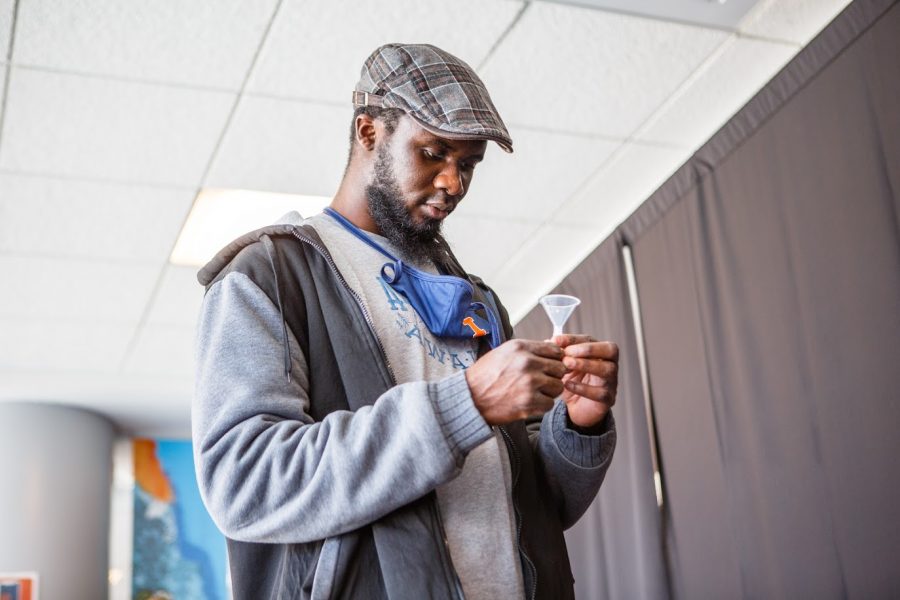How health officials hunt for COVID-19 hotspots and variants
Illinois student Tom Wheeler takes a University COVID-19 test at the ARC on Feb. 1. The University tests about 10,000 students per day.
Mar 1, 2021
As COVID-19 cases continue to rise steadily, the University’s SHIELD team has been actively studying the distribution of COVID-19 cases by location in order to instruct certain locations to begin testing more frequently than others, a safety measure that was also employed in the fall semester.
According to data shown in the recently updated COVID-19 dashboard, the University tests around 10,000 students a day, with 9,972 students being tested on Feb. 25. These tests are only broken down by population on the dashboard; however, the SHIELD team also analyzes what locations these cases are coming from, according to Allison Copenbarger Vance, a spokesman for the University and a Content Strategy Director in Public Affairs.
“We have some data scientists and other experts — epidemiologists as well — who sort of look at the way that the infection basically patterns or trends in our own University community to see what mitigation steps we might need to take,” Vance said. “So, you know, in terms of how it’s spreading, they are looking at the number of cases, where those cases are and how many cases are in each area every single day.”
Following these analyses, the experts make recommendations about how to proceed. One of these recommendations involves implementing an every-other-day-testing-order for entire housing locations, such as residence halls, apartments or private-certified housing.
Residences in a location that has been determined to require every other day testing must do so because the location has received either one positive case in the past three days or three or more cases in the past seven days.
Get The Daily Illini in your inbox!
“The reason they do it by building and not by specific address is because, of course, we also want to make sure that we are protecting individuals’ privacy,” Vance said.
When the team notices a location that falls under this criteria, they flag the location and alert the rest of the team that the location must immediately be forced to test every other day.
“Typically we do that once per week,” Vance said. “We make that change once per week unless the SHIELD team notices an increase midweek.”
After the SHIELD team communicates that a building meets the criteria to the Office of Student Affairs, an email is sent to all residents alerting them of this change.
“Their building access status has also changed to be every other day, so the technical piece is that they’re in both the boarding pass and the Safer Illinois app,” Vance said. “It will change so that they are on every other day instead of twice per week.”
Typically, the distribution is evenly split between residence halls, private-certified housing and private apartments. However, the buildings required to partake in this safety measure fluctuate consistently.
“Every week when we put people on those lists, we also take people off of those lists,” Vance said. “So it’s a different building based on what the data is telling us. Sometimes if locations continue to show that they still are having three more cases in the last seven days, they will be left on the list. But there’s a lot of movement on that list, on or off.”
Digging for variants
Besides closely analyzing data for patterns in location, the Champaign-Urbana Public Health District has also been sequencing samples for the B117 variant if they meet the criteria set forth by the CDC.
Sequencing occurs in the lab and is used to determine specific strains of the virus, according to Awais Vaid, Deputy Administrator and Epidemiologist of the CUPHD.
“It takes not just hours but days to sequence samples,” Vaid said. “So not every single sample is set up to be sequenced when they do the PCR testing of a sample. And if certain characteristics are met, then those are the ones that are then sent for sequencing.”
The CDC has established two criteria that must be met: the S gene must not be present and the cycle time must be below 28. If the sample meets these, the CDC recommends it to be sequenced.
Though the community has confirmed at least a dozen cases of the B117 variant in the community, the spread appears to be limited.
“We have been keeping a very close watch on the number of cases and we are trying to catch those, even the probable cases, very early and prioritize their case investigation and contact tracing,” Vaid said. “So because of that, I think we are confident at this point it has not occurred as much so far.”
While the CUPHD has not determined a specific location that has tested positive for cases of the variant, it is closely monitoring travel.
“I know that there were some cases that were suspected cases that had travel related to it, but then there were others which did not have any travel at all,” Vais said. “So at this time, you know, it’s not very clear if all the cases that are coming in our travel-related or if the ones with the B117 variant have been circulating in the community for a while and we are just now identifying those cases.”
The Pfizer and Moderna vaccines have been determined to be effective in combating the B117 variant of COVID-19.
“I think for people, it is important that even though the B117 variant is a major concern for us, we do know that the vaccines are effective,” Vaid said. “And so if it is your turn to get the vaccine and the vaccine appointments are available, then you should get the vaccine because it will help slow down and even prevent B117.”






